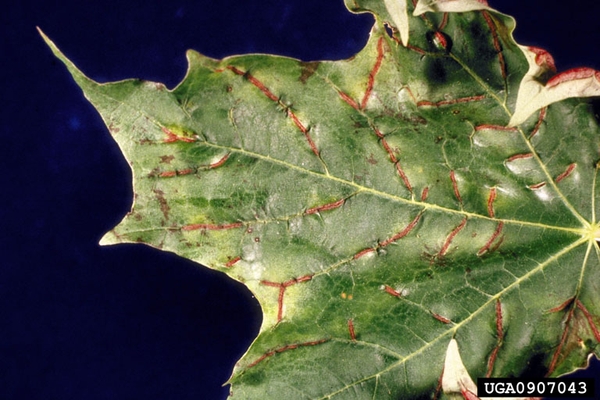Introduction
Gouty vein gall midges (Dasineura communis; Diptera: Cecidomyiidae) are gnat-like flies that form galls on maple leaves. Galls are abnormal plant growths formed in response to insect feeding or egg-laying, wounds, or infection. Gouty vein gall midge young (called larvae) inject a stimulant while feeding which causes the underside of the leaf veins to swell irregularly and turn light green to red in color. These galls may be unnoticeable or aesthetic in nature, as they can cause the leaves to curl. In more severe cases, leaf curl can reduce a tree's ability to produce energy through photosynthesis, but is not lethal to the tree. Gouty vein gall midge adults can be difficult to find in nature but the presence of their unique galls are a sign that they occur in the environment.
Biology
In temperate regions, like North Carolina, gouty vein gall midge has one generation per year. Adult gouty vein gall midge females oviposit eggs on new, developing leaf tissue in the spring. The most frequent hosts are sugar maple (Acer saccarum), red maple (A. rubrum), and boxelder (A. negundo), but other hosts have been reported. After the eggs are deposited, the larvae hatch, congregate by the leaf veins, and start to feed on the new leaves. This feeding causes the leaf tissue around the vein to swell and slowly engulf the young larvae. The gouty vein gall midge larvae use this swelling as a defense against natural enemies. The larvae mature within two months and the gall splits. In early summer, the larvae emerge and drop to the ground. They create a cocoon under leaves and debris at the base of the tree, and pupate the following spring. After pupation, the adult midges emerge, ready to mate and produce the next generation, forming new galls. Adult gall midges do not feed and do not live more than 3 days.
Management
Damage caused by the gouty vein gall midge is largely an aesthetic issue and is therefore not generally targeted for chemical treatment. However, management for high-value landscape trees may be desired, particularly if trees are infested year after year. Successful management strategies include treating trees with systemic insecticides (either as a soil drench or a spray on new leaves), as well as removing leaf litter and debris from around the base of trees to eliminate overwintering cocoons. Some success can also be achieved by removing infested leaves by hand, but this can be time consuming.
Resources
Barrett, Bruce A., 2014. Insect and Mite Galls on Missouri Trees. University of Missouri Extension.
Forest pests: Insects, diseases & other damage agents. Gall Mites and Midges, (Bladdergall, Spindlegall and Erineum Mites, Gouty Vein Midge) – Field Guild to Common Insect Pests of Urban Trees in the Northeast.
Raman, A., Schaefer, C.W. and Withers, T.M. eds., 2005. Biology, ecology, and evolution of gall-inducing arthropods (Vol. 1, pp. 273-297). Enfield: Science Publishers.
Stein, J.D. and Kennedy, P.C., 1972. Key to shelterbelt insects in the Northern Great Plains (Vol. 85). Rocky Mountain Forest and Range Experiment Station, Forest Service, US Department of Agriculture.
Publication date: Sept. 9, 2024
Recommendations for the use of agricultural chemicals are included in this publication as a convenience to the reader. The use of brand names and any mention or listing of commercial products or services in this publication does not imply endorsement by NC State University or N.C. A&T State University nor discrimination against similar products or services not mentioned. Individuals who use agricultural chemicals are responsible for ensuring that the intended use complies with current regulations and conforms to the product label. Be sure to obtain current information about usage regulations and examine a current product label before applying any chemical. For assistance, contact your local N.C. Cooperative Extension county center.
N.C. Cooperative Extension prohibits discrimination and harassment regardless of age, color, disability, family and marital status, gender identity, national origin, political beliefs, race, religion, sex (including pregnancy), sexual orientation and veteran status.


